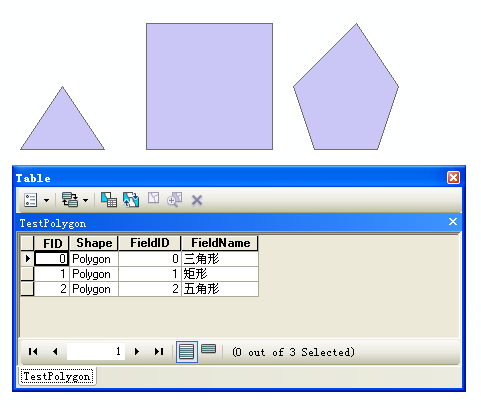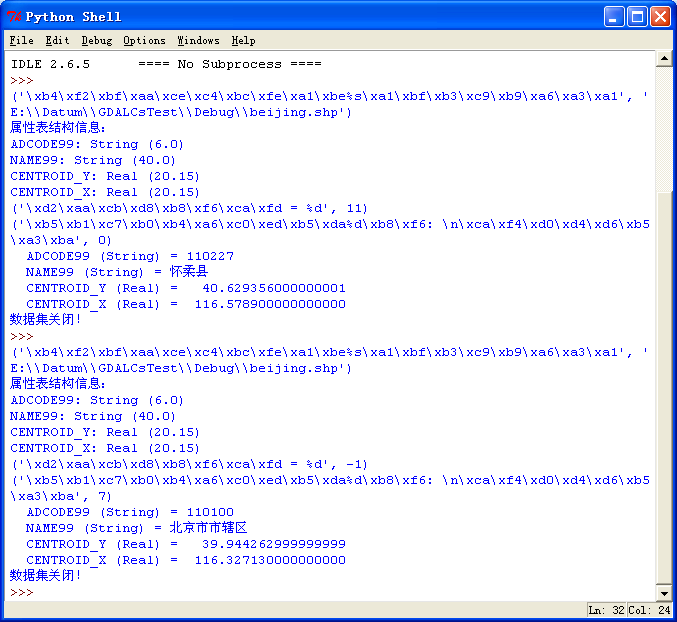GDAL读写矢量文件——Python
在Python中使用OGR时,先要导入OGR库,如果需要对中文的支持,还需要导入GDAL库,具体代码如下。Python创建的shp结果如图1所示。

图1 Python创建矢量结果
1 #-*- coding: cp936 -*- 2 try: 3 from osgeo import gdal 4 from osgeo import ogr 5 exceptImportError: 6 import gdal 7 import ogr
1.读取矢量
1 #-*- coding: cp936 -*- 2 try: 3 from osgeo import gdal 4 from osgeo import ogr 5 exceptImportError: 6 import gdal 7 import ogr 8 9 defReadVectorFile(): 10 # 为了支持中文路径,请添加下面这句代码 11 gdal.SetConfigOption("GDAL_FILENAME_IS_UTF8","NO") 12 # 为了使属性表字段支持中文,请添加下面这句 13 gdal.SetConfigOption("SHAPE_ENCODING","") 14 15 strVectorFile ="E:\\Datum\\GDALCsTest\\Debug\\beijing.shp" 16 17 # 注册所有的驱动 18 ogr.RegisterAll() 19 20 #打开数据 21 ds = ogr.Open(strVectorFile, 0) 22 if ds == None: 23 print("打开文件【%s】失败!", strVectorFile) 24 return 25 26 print("打开文件【%s】成功!", strVectorFile) 27 28 # 获取该数据源中的图层个数,一般shp数据图层只有一个,如果是mdb、dxf等图层就会有多个 29 iLayerCount = ds.GetLayerCount() 30 31 # 获取第一个图层 32 oLayer = ds.GetLayerByIndex(0) 33 if oLayer == None: 34 print("获取第%d个图层失败!\n", 0) 35 return 36 37 # 对图层进行初始化,如果对图层进行了过滤操作,执行这句后,之前的过滤全部清空 38 oLayer.ResetReading() 39 40 # 通过属性表的SQL语句对图层中的要素进行筛选,这部分详细参考SQL查询章节内容 41 oLayer.SetAttributeFilter("\"NAME99\"LIKE \"北京市市辖区\"") 42 43 # 通过指定的几何对象对图层中的要素进行筛选 44 #oLayer.SetSpatialFilter() 45 46 # 通过指定的四至范围对图层中的要素进行筛选 47 #oLayer.SetSpatialFilterRect() 48 49 # 获取图层中的属性表表头并输出 50 print("属性表结构信息:") 51 oDefn = oLayer.GetLayerDefn() 52 iFieldCount = oDefn.GetFieldCount() 53 for iAttr in range(iFieldCount): 54 oField =oDefn.GetFieldDefn(iAttr) 55 print( "%s: %s(%d.%d)" % ( \ 56 oField.GetNameRef(),\ 57 oField.GetFieldTypeName(oField.GetType() ), \ 58 oField.GetWidth(),\ 59 oField.GetPrecision())) 60 61 # 输出图层中的要素个数 62 print("要素个数 = %d", oLayer.GetFeatureCount(0)) 63 64 oFeature = oLayer.GetNextFeature() 65 # 下面开始遍历图层中的要素 66 while oFeature is not None: 67 print("当前处理第%d个: \n属性值:", oFeature.GetFID()) 68 # 获取要素中的属性表内容 69 for iField inrange(iFieldCount): 70 oFieldDefn =oDefn.GetFieldDefn(iField) 71 line = " %s (%s) = " % ( \ 72 oFieldDefn.GetNameRef(),\ 73 ogr.GetFieldTypeName(oFieldDefn.GetType())) 74 75 ifoFeature.IsFieldSet( iField ): 76 line = line+ "%s" % (oFeature.GetFieldAsString( iField ) ) 77 else: 78 line = line+ "(null)" 79 80 print(line) 81 82 # 获取要素中的几何体 83 oGeometry =oFeature.GetGeometryRef() 84 85 # 为了演示,只输出一个要素信息 86 break 87 88 print("数据集关闭!")
执行上面的代码,如果不设置属性过滤,输出内容如图3‑9上半部分所示,如过设置了属性过滤,输出内容如图3‑9下半部分所示。(Python输出的中文转为编码了)。

2.写入矢量
在使用Python创建矢量图形的时候,使用的WKT格式的字符串来进行创建。也可以使用其他的方式进行创建。代码如下,写出来的矢量图形和属性表如图1所示。
1 #-*- coding: cp936 -*- 2 try: 3 from osgeo import gdal 4 from osgeo import ogr 5 exceptImportError: 6 import gdal 7 import ogr 8 9 defWriteVectorFile(): 10 # 为了支持中文路径,请添加下面这句代码 11 gdal.SetConfigOption("GDAL_FILENAME_IS_UTF8","NO") 12 # 为了使属性表字段支持中文,请添加下面这句 13 gdal.SetConfigOption("SHAPE_ENCODING","") 14 15 strVectorFile ="E:\\TestPolygon.shp" 16 17 # 注册所有的驱动 18 ogr.RegisterAll() 19 20 # 创建数据,这里以创建ESRI的shp文件为例 21 strDriverName = "ESRIShapefile" 22 oDriver =ogr.GetDriverByName(strDriverName) 23 if oDriver == None: 24 print("%s 驱动不可用!\n", strDriverName) 25 return 26 27 # 创建数据源 28 oDS =oDriver.CreateDataSource(strVectorFile) 29 if oDS == None: 30 print("创建文件【%s】失败!", strVectorFile) 31 return 32 33 # 创建图层,创建一个多边形图层,这里没有指定空间参考,如果需要的话,需要在这里进行指定 34 papszLCO = [] 35 oLayer =oDS.CreateLayer("TestPolygon", None, ogr.wkbPolygon, papszLCO) 36 if oLayer == None: 37 print("图层创建失败!\n") 38 return 39 40 # 下面创建属性表 41 # 先创建一个叫FieldID的整型属性 42 oFieldID =ogr.FieldDefn("FieldID", ogr.OFTInteger) 43 oLayer.CreateField(oFieldID, 1) 44 45 # 再创建一个叫FeatureName的字符型属性,字符长度为50 46 oFieldName =ogr.FieldDefn("FieldName", ogr.OFTString) 47 oFieldName.SetWidth(100) 48 oLayer.CreateField(oFieldName, 1) 49 50 oDefn = oLayer.GetLayerDefn() 51 52 # 创建三角形要素 53 oFeatureTriangle = ogr.Feature(oDefn) 54 oFeatureTriangle.SetField(0, 0) 55 oFeatureTriangle.SetField(1, "三角形") 56 geomTriangle =ogr.CreateGeometryFromWkt("POLYGON ((0 0,20 0,10 15,0 0))") 57 oFeatureTriangle.SetGeometry(geomTriangle) 58 oLayer.CreateFeature(oFeatureTriangle) 59 60 # 创建矩形要素 61 oFeatureRectangle = ogr.Feature(oDefn) 62 oFeatureRectangle.SetField(0, 1) 63 oFeatureRectangle.SetField(1, "矩形") 64 geomRectangle =ogr.CreateGeometryFromWkt("POLYGON ((30 0,60 0,60 30,30 30,30 0))") 65 oFeatureRectangle.SetGeometry(geomRectangle) 66 oLayer.CreateFeature(oFeatureRectangle) 67 68 # 创建五角形要素 69 oFeaturePentagon = ogr.Feature(oDefn) 70 oFeaturePentagon.SetField(0, 2) 71 oFeaturePentagon.SetField(1, "五角形") 72 geomPentagon =ogr.CreateGeometryFromWkt("POLYGON ((70 0,85 0,90 15,80 30,65 15,700))") 73 oFeaturePentagon.SetGeometry(geomPentagon) 74 oLayer.CreateFeature(oFeaturePentagon) 75 76 oDS.Destroy() 77 print("数据集创建完成!\n")
3.矢量数据管理
1 defVectorDelete(strVectorFile): 2 # 注册所有的驱动 3 ogr.RegisterAll() 4 5 oDriver = None 6 #打开矢量 7 oDS = ogr.Open(strVectorFile, 0) 8 if oDS == None: 9 os.remove(strVectorFile) 10 return 11 12 oDriver = oDS.GetDriver() 13 if oDriver == None: 14 os.remove(strVectorFile) 15 return 16 17 ifoDriver.DeleteDataSource(strVectorFile) == ogr.OGRERR_NONE: 18 return 19 else: 20 os.remove(strVectorFile) 21 22 defVectorRename(strOldFile, strNewFile): 23 # 注册所有的驱动 24 ogr.RegisterAll() 25 26 oDriver = None 27 #打开矢量 28 oDS = Ogr.Open(strOldFile, 0) 29 if oDS == None : 30 os.rename(strOldFile,strNewFile) 31 return 32 33 oDriver = oDS.GetDriver() 34 if oDriver == None: 35 os.rename(strOldFile,strNewFile) 36 return 37 38 oDDS = oDriver.CopyDataSource(oDS,strNewFile, None) 39 if oDDS == None: 40 os.rename(strOldFile,strNewFile) 41 42 if oDriver.DeleteDataSource(strOldFile)== ogr.OGRERR_NONE: 43 return 44 else : 45 os.rename(strOldFile,strNewFile)
文章来源:http://blog.csdn.net/liminlu0314/article/details/8828983



